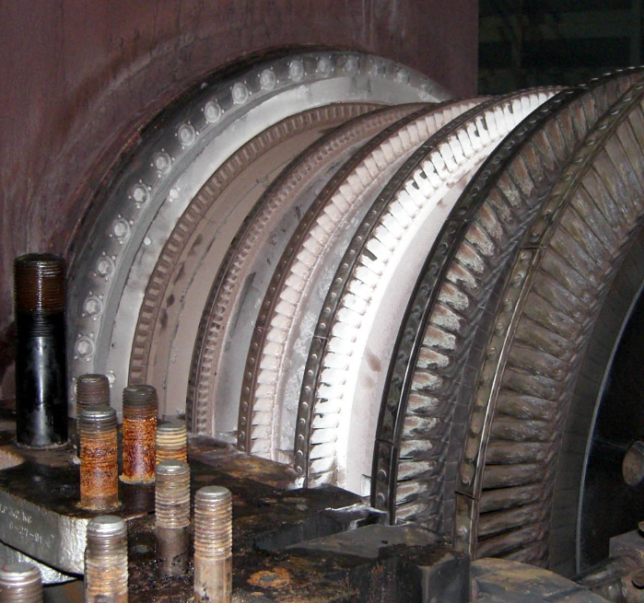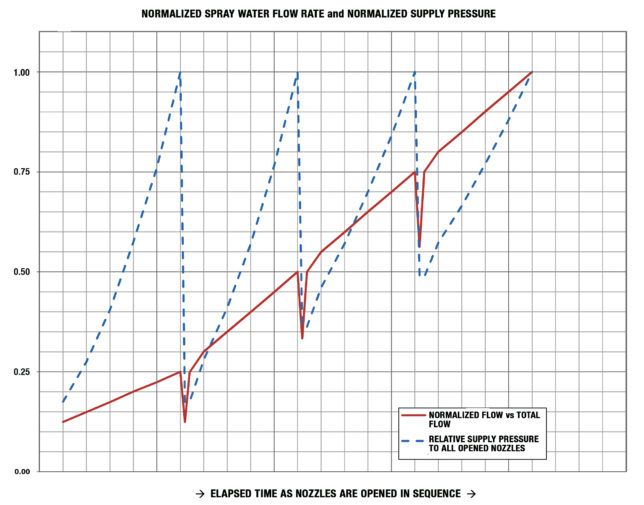STEAM TURBINE WATER WASHING
HOW TO SAFELY REMOVE WATER-SOLUBLE MINERAL DEPOSITS UNDER NORMAL OPERATING CONDITIONS
BY DAVID STASENKO & JOSEPH REDOVAN

Caption: Turbine rotor with mineral deposits.
Water washing of steam turbines has long been done at reduced loads, flows and speeds using special equipment in the steam inlet piping. More recently, however, conservative application limits have been developed to implement water washing within normal operating conditions, including for some of the generally dry stages of the condensing section of a steam turbine. This procedure allows water washing to be carried out within the normal operating range of speeds and steam flows.
Water injected into an operating steam turbine can remove contaminant mineral compounds that have plated onto the airfoil surfaces (Figure 1). The controlled injection of water increases the moisture content of the wet stages and moves the moisture transition point further upstream. Water-soluble deposits might then be washed from those normally dry stages. However, adequate monitoring and careful control of the water washing process are required to prevent damage to the steam turbine during the washing process.
Before water washing, the end user must complete performance trend monitoring of key operating parameters, including speed, power, section flows and internal pressures. This helps to determine the degree of degradation of the turbine. Gradual long-term increases in flow or turbine steam path pressures at the same nominal operating conditions provide a good indication that mineral deposits are partially obstructing the steam path.
An engineering study was done to verify that steam turbine internal parts could withstand the effects of the thermal transient caused by injecting relatively cold water into the hot casing and valve lifting bar. After careful review of both the transient thermal analysis as well as a low cycle fatigue analysis, the conclusion is that there is no risk of the valve lift bar failing within the conditions analyzed.

Caption: Schematic example of ramping water wash flow with four nozzles.
The basic procedure for water washing does not change with speed or load. However, the risk of damage to the turbine steam path does increase compared to washing at reduced speeds and loads. During water washing, the water injection f low should be increased and decreased at a limited rate to minimize the risk of axial rubs from unequal cooling or heating of the steam turbine rotor and casing.
Although the water flow rate can be gradually moved up or down, this change is usually intermittent or in steps in a multi-nozzle system (Figure 2). There are several reasons for this. The minimum water pressure for atomization should be approximately 30 psi greater than the injection location. This leads to a nonzero flow at the start of washing. Additionally, when bringing spray nozzles online one at a time, the supply pressure to the opened nozzles should be quickly decreased before the next nozzle is opened. The pressure should then be increased to all open nozzles to approximate an overall ramping flow rate. This helps maintain a smoother overall temperature ramp rate.
Finally, as each nozzle is opened, it should have a low flow of “tempering” water initially introduced to minimize thermal shock. The supply pressure should then be quickly increased to the pressure required to obtain the f low fraction that provides a smooth increase in water flow. Water washing can remove water-soluble mineral deposits from the internal surfaces of a steam turbine within the normal operating range of speeds and steam flows. This water washing procedure can be performed on a straight-condensing machine or the condensing (low pressure or LP) section of a turbine with a controlled extraction.
David Stasenko is a Senior
Aerodynamic Engineer at
Elliott Group, USA. Elliott
developed the water washing
procedure discussed in
this article.
Joseph Redovan is a Stress
Analysis Engineer at Elliott.
For more information, visit
www.elliott-turbo.com